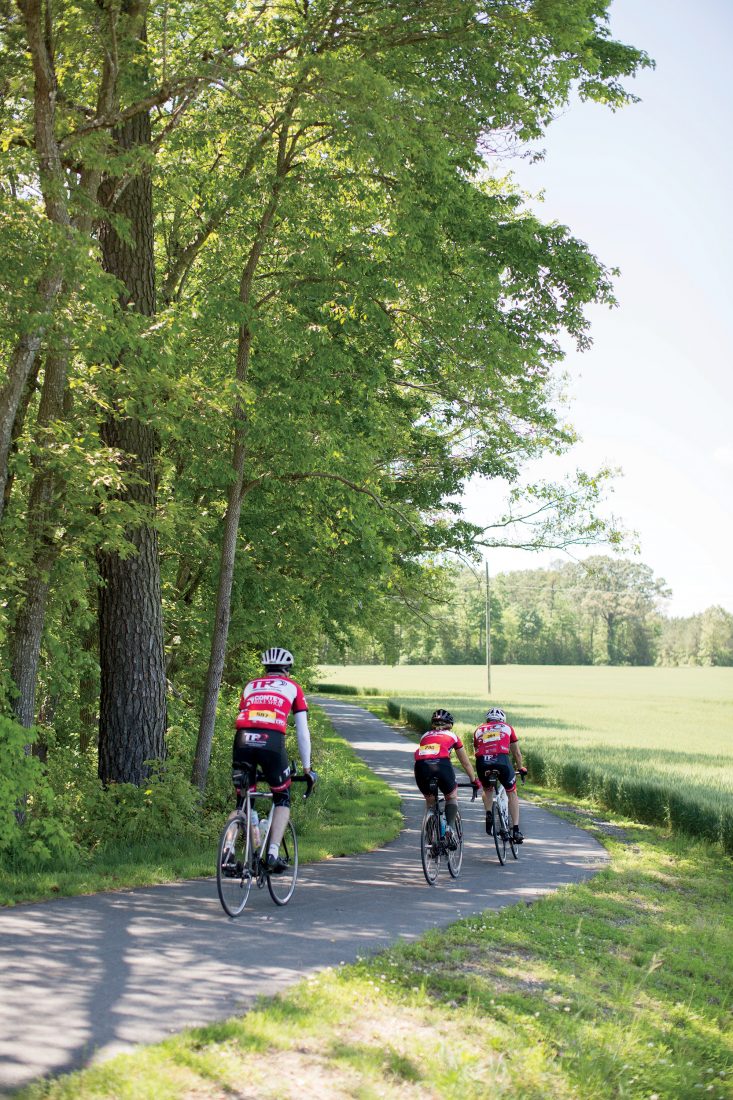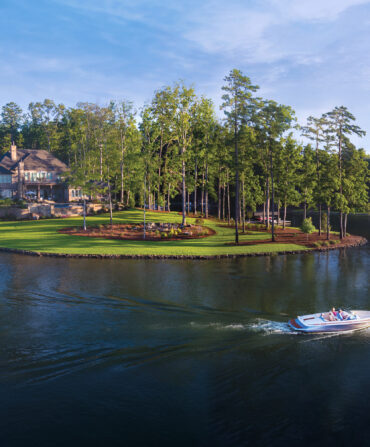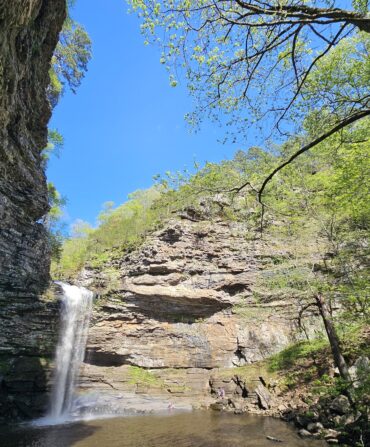Not long after making landfall at Jamestown in 1607, a small band of English explorers sailed their way up the James River until they reached the rapids and shallows at the site that would become Richmond. Four hundred years later, the much-anticipated fifty-two-mile Virginia Capital Trail offers an equally scenic if less arduous way to retrace the route. Completed last fall, the pedestrian and bike path—now part of the cross-country TransAmerica Trail for cyclists—links the state’s first capital with its current one through arguably the most historically rich corridor in the South. On a sunny weekend, the cyclist and historian in me can’t resist embarking on my own expedition.
I set out from the downtown Richmond trailhead in Great Shiplock Park on a well-signposted track that follows the James east through what were once the tribal lands of Chief Powhatan and Pocahontas, past the great houses of colonial times, and by both Revolutionary and Civil War battlegrounds.
The crowd of runners, amblers, dog walkers, and families with baby strollers thins as the city fades in the west, ceding the gently rolling ribbon of asphalt to cyclists, both upright and recumbent, in singles and groups. Soon, however, it’s mostly just me, the sun dancing on trailside beds of perennials, and my bike purring over fresh tarmac. Two of the first potential stops are Civil War sites: Fort Harrison, part of the Richmond defenses taken by Grant in 1864, just south of the trail, and Malvern Hill, where the last of the Seven Days Battles was fought, just north of it. There were some eight thousand casualties at Malvern Hill, making it one of Virginia’s most poignant battlefields.
With a maximum elevation of only 160 feet, the trail is mostly easy going. Just before lunchtime, I am caught from behind on a downhill by a burly, tatted mountain biker working off a hangover. We chat for a while until he falls off the pace as we hit a rise toward Shirley Plantation.
 While the heavily wooded trail itself offers only rare glimpses of the James, many estates open to the public have spectacular river views. I turn toward Shirley, where the eleventh and twelfth generations of the Carter family still live and run a working farm. At its entrance, however, I veer off to the newly minted Upper Shirley Vineyards winery and restaurant, which serves lunch and a selection of small plates along with its first vintages of Viognier, Cabernet Franc, and a leggy Tannat. After a spin through the wine-tasting menu, I repair to a broad porch to enjoy what must be the South’s most seductive burger and view combo: the juicy Route 5 Burger—a brisket, short rib, and chuck blend with Vidalia onions and comeback sauce—and a serene lookout on the river and Turkey Island, a National Wildlife Refuge teeming with bald eagles.
While the heavily wooded trail itself offers only rare glimpses of the James, many estates open to the public have spectacular river views. I turn toward Shirley, where the eleventh and twelfth generations of the Carter family still live and run a working farm. At its entrance, however, I veer off to the newly minted Upper Shirley Vineyards winery and restaurant, which serves lunch and a selection of small plates along with its first vintages of Viognier, Cabernet Franc, and a leggy Tannat. After a spin through the wine-tasting menu, I repair to a broad porch to enjoy what must be the South’s most seductive burger and view combo: the juicy Route 5 Burger—a brisket, short rib, and chuck blend with Vidalia onions and comeback sauce—and a serene lookout on the river and Turkey Island, a National Wildlife Refuge teeming with bald eagles.
You could easily break up the ride over a week with time in Richmond, Williamsburg, and Jamestown. Historic B&Bs, such as Edgewood Plantation and North Bend Plantation, are on or near the route, as are Cul’s Courthouse Grille (home of the Governor Wilder catfish sandwich), Ronnie’s BBQ, and Haupt’s Country Store for fried chicken to go. But with thirty-one more miles to conquer this afternoon to reach Jamestown, I dine and dash, riding now through a stretch of countryside stacked with grand old colonial great houses.
Berkeley, a 1726 Georgian mansion, is the home of America’s first bourbon, a Declaration of Independence signer (Benjamin Harrison V), a president (William Henry Harrison), and the bugle tune “Taps,” which a Union soldier arranged here during the war. Just down the river, the Byrd family estate, Westover, is an exemplar of Georgian architecture, and the pews of the adjacent 1730 Westover Episcopal Church once welcomed Washington, Jefferson, and later Theodore Roosevelt, who dropped in to worship among the Byrds, Carters, Harrisons, and Tylers.
I pedal on and reach Sherwood Forest Plantation. At 301 feet, it’s the nation’s longest frame house and was once owned by President John Tyler, who added a sixty-eight-foot ballroom in 1845 so that his guests could dance the Virginia reel. Whether you stop or not, you can’t help but inhale the perfume of history as you cruise by.
 The trail continues east through pine forests, sandy soil, and swamps that lead to a bridge over the Chickahominy River, up which Captain John Smith once sailed looking for a passage to the Pacific. Captured by Chief Powhatan’s warriors, Smith was famously saved by Powhatan’s daughter Matoaka, a.k.a. Pocahontas.
The trail continues east through pine forests, sandy soil, and swamps that lead to a bridge over the Chickahominy River, up which Captain John Smith once sailed looking for a passage to the Pacific. Captured by Chief Powhatan’s warriors, Smith was famously saved by Powhatan’s daughter Matoaka, a.k.a. Pocahontas.
A final stretch before Jamestown passes through a field where Cornwallis and Lafayette once clashed. After four hours and forty minutes in the saddle, sixty-three miles under my belt, and umpteen historical markers read, or at least skimmed, I reach Wedmore Place, the twenty-eight-room European-style country hotel on the Williamsburg Winery’s three-hundred-acre estate. Waiting on ice is a bottle of the house brut sparkler—just the tonic after a full day on the trail. I’m looking forward to a restful night before my return trip to Richmond. But having expended (according to my bike computer) 3,244 calories, I refuel at the inn’s Café Provençal via scallops with sweet potato dumplings and lamb bacon, seared local rockfish, and the winery’s award-winning Adagio blend—a sweet reward for the day’s labor.









